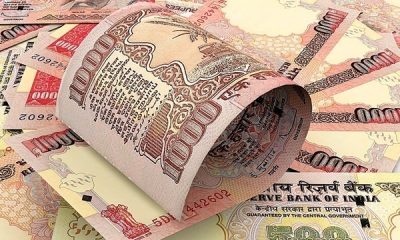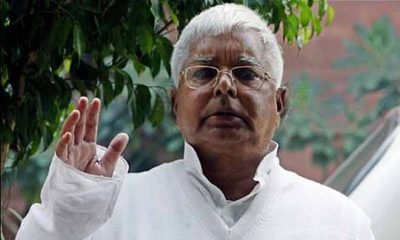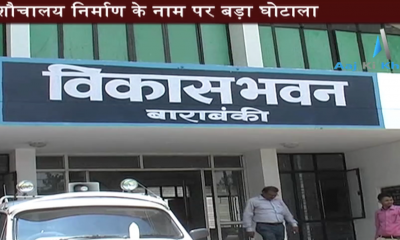Feature
Black money law comes into force from Thursday

New Delhi: With the compliance window closing, what is called India’s black money act, came into force from Thursday.
“Once the window is closed, the act with all its provisions will be enforced on defaulters,” Central Board of Direct Taxes (CBDT) chairperson Anita Kapur told the media here.
The Undisclosed Foreign Income and Assets (Imposition of Tax) Act, 2015, for the first time, allows levy of tax in India on assets kept abroad.
The law provides for a compliance window for declaring and paying penalty and a failure to meet the timeline will attract an additional penalty of 90 percent for a total tax liability of 120 percent on the quantum of black money stashed abroad.
“It is for the persons who have assets abroad, and their conduct is not under our control, to take advantage or to ignore the opportunity,” Kapur said.
“We clarified a lot of queries of people. We also facilitated their filing till midnight (Wednesday), as we got some last minute requests from places other than Delhi,” she added.
India’s drive to get back ill-gotten wealth stashed away by its citizens abroad has drawn responses from 638 declarants for total assets worth Rs.3,770 crore ($580 million), an official statement said.
September 30 was the last date under the amnesty scheme, that called for a tax of 30 percent and an equal amount in penalty, to be paid before December 31. The compliance window opened on July 1.
In a second set of clarifications in the frequently asked questions (FAQs) format, the government last month reiterated total confidentiality of information furnished to unearth black money stashed abroad.
The finance minstry also relaxed conditions for those who cannot get bank statements of their foreign accounts, saying it would accept their “best estimate” declarations with a rider that a penalty would follow if disclosures were incomplete.
In the 27 FAQs, following those issued in July, on voluntary disclosures to be made in the 90-day compliance window ended September 30, the ministry said the new law incorporates the provisions of section 138 of the Income Tax Act relating to disclosure of information in respect of assesses.
The income tax department in an earlier list of FAQs, had also said disclosures made under the said act would have “immunity from prosecution under the Foreign Exchange Management Act (FEMA), Prevention of Money Laundering Act (PMLA), Income Tax Act, Wealth Tax Act, Companies Act and Customs Act”.
It, however, does not provide immunity from prosecution under any other statute.
The offence of wilful attempt to evade tax will also not be an offence under the PMLA, the FAQs said.
The one-time 90-day compliance window for declaring, however, does not guarantee immunity for wealth generated from corruption, it added.
India has no official estimate about the quantum of black money stashed away by Indians abroad but unofficial estimate puts the sum somewhere between $466 billion and $1.4 trillion.
Entertainment
Meghalaya Reserves Legalized Gambling and Sports Betting for Tourists

The State Scores Extra High on Gaming-Friendly Industry Index
Meghalaya scored 92.85 out of 100 possible points in a Gaming Industry Index and proved to be India’s most gaming-friendly state following its recent profound legislation changes over the field allowing land-based and online gaming, including games of chance, under a licensing regime.
The index by the UK India Business Council (UKIBC) uses a scale of 0 to 100 to measure the level of legalisation on gambling and betting achieved by a state based on the scores over a set of seven different games – lottery, horse racing, betting on sports, poker, rummy, casino and fantasy sports
Starting from February last year, Meghalaya became the third state in India’s northeast to legalise gambling and betting after Sikkim and Nagaland. After consultations with the UKIBC, the state proceeded with the adoption of the Meghalaya Regulation of Gaming Act, 2021 and the nullification of the Meghalaya Prevention of Gambling Act, 1970. Subsequently in December, the Meghalaya Regulation of Gaming Rules, 2021 were notified and came into force.
All for the Tourists
The move to legalise and license various forms of offline and online betting and gambling in Meghalaya is aimed at boosting tourism and creating jobs, and altogether raising taxation revenues for the northeastern state. At the same time, the opportunities to bet and gamble legally will be reserved only for tourists and visitors.
“We came out with a Gaming Act and subsequently framed the Regulation of Gaming Rules, 2021. The government will accordingly issue licenses to operate games of skill and chance, both online and offline,” said James P. K. Sangma, Meghalaya State Law and Taxation Minister speaking in the capital city of Shillong. “But the legalized gambling and gaming will only be for tourists and not residents of Meghalaya,” he continued.
To be allowed to play, tourists and people visiting the state for work or business purposes will have to prove their non-resident status by presenting appropriate documents, in a process similar to a bank KYC (Know Your Customer) procedure.
Meghalaya Reaches Out to a Vast Market
With 140 millions of people in India estimated to bet regularly on sports, and a total of 370 million desi bettors around prominent sporting events, as per data from one of the latest reports by Esse N Videri, Meghalaya is set to reach out and take a piece of a vast market.
Estimates on the financial value of India’s sports betting market, combined across all types of offline channels and online sports and cricket predictions and betting platforms, speak about amounts between $130 and $150 billion (roughly between ₹9.7 and ₹11.5 lakh crore).
Andhra Pradesh, Telangana and Delhi are shown to deliver the highest number of bettors and Meghalaya can count on substantial tourists flow from their betting circles. The sports betting communities of Karnataka, Maharashtra, Uttar Pradesh and Haryana are also not to be underestimated.
Among the sports, cricket is most popular, registering 68 percent of the total bet count analyzed by Esse N Videri. Football takes second position with 11 percent of the bets, followed by betting on FIFA at 7 percent and on eCricket at 5 percent. The last position in the Top 5 of popular sports for betting in India is taken by tennis with 3 percent of the bet count.
Local Citizens will Still have Their Teer Betting
Meghalaya residents will still be permitted to participate in teer betting over arrow-shooting results. Teer is a traditional method of gambling, somewhat similar to a lottery draw, and held under the rules of the Meghalaya Regulation of the Game of Arrow Shooting and the Sale of Teer Tickets Act, 2018.
Teer includes bettors wagering on the number of arrows that reach the target which is placed about 50 meters away from a team of 20 archers positioned in a semicircle.
The archers shoot volleys of arrows at the target for ten minutes, and players place their bets choosing a number between 0 and 99 trying to guess the last two digits of the number of arrows that successfully pierce the target.
If, for example, the number of hits is 256, anyone who has bet on 56 wins an amount eight times bigger than their wager.























